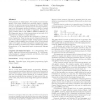Free Online Productivity Tools
i2Speak
i2Symbol
i2OCR
iTex2Img
iWeb2Print
iWeb2Shot
i2Type
iPdf2Split
iPdf2Merge
i2Bopomofo
i2Arabic
i2Style
i2Image
i2PDF
iLatex2Rtf
Sci2ools
PLPV
2010
ACM
2010
ACM
Arity-generic datatype-generic programming
Some programs are doubly-generic. For example, map is datatypegeneric in that many different data structures support a mapping operation. A generic programming language like Generic Haskell can use a single definition to generate map for each type. However, map is also arity-generic because it belongs to a family of related operations that differ in the number of arguments. For lists, this family includes repeat, map, zipWith, zipWith3, zipWith4, etc. With dependent types or clever programming, one can unify all of these functions together in a single definition. However, no one has explored the combination of these two forms of genericity. These two axes are not orthogonal because the idea of arity appears in Generic Haskell: datatype-generic versions of repeat, map and zipWith have different arities of kind-indexed types. In this paper, we define arity-generic datatype-generic programs by building a framework for Generic Haskell-style generic programming in the dependently-typed ...
Generic Haskell | Generic Programming Language | Haskell-style Generic Programming | PLPV 2010 | Programming Languages |
| Added | 17 Mar 2010 |
| Updated | 17 Mar 2010 |
| Type | Conference |
| Year | 2010 |
| Where | PLPV |
| Authors | Stephanie Weirich, Chris Casinghino |
Comments (0)

